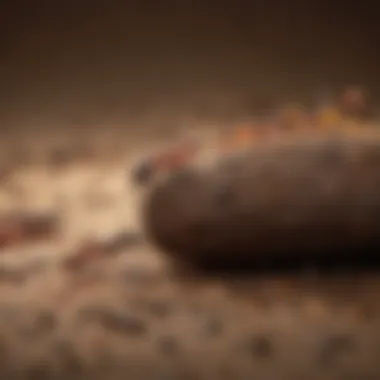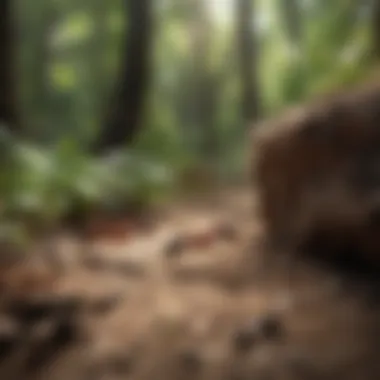Effective Strategies for Managing Cut Ant Populations


Intro
In recent years, the issue of managing cut ant populations has garnered significant attention. The aggressive nature of these ants, coupled with their ability to cause extensive damage to vegetation and ecosystems, calls for a nuanced understanding and a systematic approach to control them. This article unpacks the complexities associated with cut ant control, focusing on their biological traits, ecological impacts, and the various control strategies available. By equipping students, researchers, educators, and professionals with knowledge, we hope to raise awareness and inspire action against these industrious pests.
Methodology
Understanding the issue at hand requires a solid foundation of research and data collection. In this section, we will delve into the methods employed to study cut ants and their impact.
Overview of Research Methods Used
The exploration of cut ant behavior and population dynamics has primarily relied on observational and experimental research. Scientists often conduct field studies to observe ant trails, foraging behavior, and nesting patterns. These observations can inform more structured experiments in controlled environments. Furthermore, molecular techniques like DNA barcoding are increasingly utilized to identify specific ant species and analyze genetic diversity within populations.
Data Collection Techniques
A variety of data collection methods are employed to understand and manage cut ant populations effectively:
- Field Observation: Researchers spend time in natural habitats to track ant movements and behaviors.
- Sampling Methods: Using pitfall traps or bait stations to gather ants for identification and analysis.
- Surveys: Community surveys to assess local knowledge and experiences with cut ant infestations.
- Laboratory Experiments: Implementing controlled tests to assess the efficacy of various control techniques.
These methods together create a robust framework for understanding the ecology of cut ants and evaluating the effectiveness of intervention strategies.
"Effective management of cut ants hinges not only on understanding their biology but also on the implementation of integrated control practices that consider ecological balance."
Future Directions
As we look ahead, the research landscape regarding cut ants is rapidly evolving. Here's what to expect:
Upcoming Trends in Research
- Sustainable Solutions: There is a growing emphasis on eco-friendly control methods that minimize harm to non-target species and the environment.
- Technological Advances: Incorporation of remote sensing technology to monitor ant populations over larger areas accurately.
- Interdisciplinary Studies: Collaboration between ecologists and social scientists to examine the socio-economic impacts of cut ant infestations on communities.
Areas Requiring Further Investigation
Key areas that still warrant thorough research include:
- Understanding the long-term ecological impacts of various control methods.
- Developing community-based approaches to combine local knowledge with scientific strategies.
- Evaluating the effectiveness of biological control agents, such as natural predators or parasites.
As our understanding deepens, it’s clear that the fight against cut ants requires a comprehensive approach that integrates knowledge across disciplines and actively engages communities. By refining our methods and expanding our focus areas, we can create more effective strategies for managing these tenacious insects.
Understanding Cut Ant Behavior
Understanding the behavior of cut ants is critical to effectively manage their populations. These small yet industrious creatures have a unique set of characteristics that influence how they interact with their environment, their foraging habits, and their colony organization. When we grasp the behavior of cut ants, we set the stage for selecting the most appropriate control measures. The knowledge gained here informs not just pest control strategies, but also contributes to broader ecological understanding, ensuring that efforts made do not inadvertently harm the environment.
Biology of Cut Ants
Cut ants, belonging primarily to the genus Atta and Acromyrmex, offer fascinating insights into social insects. Their biology is complex, with specialized roles within the colony. For instance, the queen ant is the linchpin of the entire colony, focused primarily on reproduction, while worker ants take on myriad jobs from foraging, caring for the young, to defending the nest. The cut ant's ability to harvest plant material to cultivate fungus is particularly noteworthy, creating a symbiotic relationship that fuels their survival. Understanding these biological intricacies helps in developing specific control strategies. For example, targeting the queen could potentially diminish the population significantly, abnormality species’ behavior due to environmental factors plays a part in determining effective control techniques as well.
Foraging Patterns
Foraging is what keeps cut ant colonies thriving, as they search for materials to bring back home. These ants are not just roaming about randomly. They typically follow well-worn trails that act as highways between their nest and food sources. Interestingly, they tend to cut leaves and plant parts, which they carry back to their nests. They also communicate with each other through pheromones, marking paths to abundant food sources. Recognizing these patterns can be instrumental for residents or land managers intending to mitigate ant populations. By understanding when and where ants are foraging, it becomes easier to introduce control measures at key points of their activity.
Colony Structure
The structure of a cut ant colony is a marvel of evolutionary design. Generally, these colonies comprise a queen, workers, and sometimes male ants that have but one purpose: mating with the queen. A healthy colony can number in the thousands, sometimes tens of thousands. The organization promotes efficiency—worker ants may have specific roles, whether it's foraging, brood care, or nest building. This intricate division of labor not only maintains the colony but enhances its resilience against environmental disturbances. When attempting to control cut ant populations, understanding the colony structure can guide individuals on how to disrupt their life cycle and reduce colony size.
"Knowledge of ant behaviors and biology is essential for developing effective strategies against infestation."
Overall, examining the behaviors, biology, and colony structure equips us with essential tools for understanding cut ants. This knowledge does not only aid in control strategies but also fosters a respect for their role in the ecosystem, laying the groundwork for more sustainable and balanced approaches to ant management.
Ecological Impact of Cut Ants
Understanding the ecological impact of cut ants is essential, as these small insects play a surprisingly large role in shaping their environments. Their activities influence nutrient cycling, seed dispersal, and even the structure of various ecosystems. By exploring the significance of these impacts, we can appreciate how cut ants fit into the intricate web of life.
Role in Ecosystems
Cut ants, particularly the Atta species, are often considered ecosystem engineers. They effectively modify their surroundings through their foraging and nesting behaviors. By consuming large quantities of plant material, they help to breakdown organic matter and return nutrients to the soil, enriching it over time. Additionally, their extensive underground tunnel systems aerate the soil, enhancing water infiltration and promoting healthier root growth.
Their foraging habits also affect plant communities. They tend to favor certain plant species, which in turn can impact those plants' reproductive strategies. Some plants may evolve characteristics to deter foraging or may start relying more on asexual reproduction when faced with significant ant pressure.
Effects on Biodiversity
Cut ants have a complex relationship with biodiversity. On one hand, they can enhance the variety of plant life by promoting a heterogeneous environment. As they transport seeds, which they often do without consuming them, they aid in the spread of various plant species. On the other hand, their relentless foraging can lead to a decline in certain plants, particularly those that are less adaptable to ant disturbance.


Here are some specific ways cut ants impact biodiversity:
- Seed Dispersal: They facilitate the growth of some plant species by transferring their seeds to suitable germination sites.
- Competition: They may outcompete other herbivores for certain plant species, which can shift ecosystem dynamics.
- Food Source: Cut ants serve as food for various predators, integrating them into multiple food webs and contributing to overall biological diversity.
Interactions with Other Species
The connections cut ants maintain with other species are quite crucial to ecosystem balance. For instance, some plants develop mutualistic relationships with cut ants, which protect these plants from herbivores in exchange for food. This symbiotic relationship exemplifies how cut ants influence not only plant communities but also contribute to ecological stability.
Conversely, cut ants face threats from various natural enemies, such as certain parasitic fungi and predatory insects. These interactions help regulate ant populations and prevent any one colony from overwhelming an area, thus maintaining a balance in the ecosystem.
Ultimately, cut ants embody a fine dance within nature. Their influence ripples through the ecosystem, impacting not just food chains but the very structure of environments, acting as both a boon and a bane to biodiversity.
"Ecosystem health often hinges on the seemingly insignificant players within it. Understanding their roles can be illuminating for conservation efforts."
In sum, addressing the ecological impacts of cut ants is not merely an academic exercise. It allows for a deeper comprehension of their vital roles and the importance of maintaining balanced ecosystems.
Identifying Cut Ant Infestations
Recognizing cut ant infestations is crucial for any effective management strategy. Knowing the signs and techniques for monitoring these pests arms us with the knowledge to tackle an issue before it spirals out of control. The ability to accurately identify these infestations offers several benefits, including preventing damage to the ecosystem and agricultural products, protecting structures, and ultimately saving both time and resources.
Cut ants are notoriously difficult to spot at first glance, as their colonies often remain hidden underground or in decaying wood, making awareness and early detection pivotal. The earlier the signs of an infestation are discovered, the better equipped one can be to act decisively, potentially thwarting a burgeoning problem before it causes significant harm.
Signs of Activity
The first step in identifying cut ant infestations is recognizing the signs of their activity. Here are some key indicators:
- Mound Formation: One of the most visible signs is the presence of mounds. These nests can range in size but are often seen as raised dirt structures. Pay close attention to the locations, especially near trees or garden beds.
- Foraging Trails: As cut ants go about their business, they create visible trails connecting food sources to their nests. You might spot them marching in lines, which often leads straight to a disturbance.
- Leaf Cutting: Observing cut leaves, often scattered around the nest entrance, is a strong indicator that these pests are active in your area. They will cut leaves into manageable pieces for transporting back to their colony.
- Unusual Sounds: In some instances, if you listen closely, the sound of ants moving—especially when in large numbers—can be discernible, especially if they are working vigorously on a nearby food source.
Recognizing these signs early can help homeowners, gardeners, and agricultural professionals take appropriate action to manage the populations effectively.
Monitoring Techniques
Once signs of cut ant activity are noticed, employing monitoring techniques becomes paramount. Through these methods, ongoing infestations can be tracked, providing data that informs future control measures. Some effective strategies include:
- Visual Inspections: Regularly inspect areas where cut ants have been identified. This includes checking around structures, gardens, and natural habitats. Frequent checking can reveal new colonies or activity spikes.
- Bait Stations: Utilizing bait stations can help in monitoring cut ant populations. These stations attract foraging workers, allowing for observation of their numbers and even the potential identification of the species present.
- Soil Analysis: In some advanced cases, soil samples can be analyzed to detect pheromones left by ants or the presence of larvae within the soil. This method can determine whether action is required in specific areas.
- Camera Traps: For researchers or in persistent infestation scenarios, deploying camera traps can capture real-time footage of activity patterns, giving insights into peak activity times and further informing pest management strategies.
Monitoring isn't merely a way to observe. It's an essential tool for crafting an effective management plan, ensuring that control measures address the specific needs of each situation.
"Identifying and monitoring pest activity isn’t just about detection; it’s about understanding their patterns to combat them effectively."
Engaging in thorough identification practices provides a clearer picture of how cut ants interact with their environment, ultimately empowering stakeholders to make informed decisions about control measures.
By keeping a vigilant eye on the signs of infestation and utilizing effective monitoring techniques, one can stay a step ahead of cut ant populations, paving the way for successful management.
Conventional Control Methods
When faced with the persistent challenge of cut ants, employing conventional control methods becomes paramount. These strategies offer immediate results and can be tailored to fit various environments where cut ants wreak havoc. Such methods typically involve chemical and mechanical interventions, each with its unique advantages and considerations. Understanding the nuances of these techniques allows homeowners, land managers, and agricultural professionals to make informed decisions in their ant management efforts.
Chemical Pesticides
Chemical pesticides have long been the go-to choice for controlling pest populations, and cut ants are no exception. These substances can penetrate the complex social structures of ant colonies, delivering a targeted strike that can disrupt their activities. The primary appeal of chemical pesticides lies in their quick action; they can eliminate visible ant trails and reduce populations rapidly. However, several aspects need consideration:
- Resistant Populations: Over-reliance can lead to resistance, rendering certain chemicals ineffective over time.
- Non-Target Species: Unintended consequences can arise, potentially harming beneficial insects and disrupting local ecosystems.
- Residues: Concern arises regarding chemical residues in food production areas, necessitating adherence to safety guidelines and usage regulations.
Due to these factors, many experts advocate for integrated pest management, combining chemical options with other methods for optimal results.
Baiting Systems
Baiting systems present a refined approach to cut ant management. In essence, these systems lure ants with attractive substances while delivering a lethal dose. This method capitalizes on the foraging behavior of ant colonies, where worker ants carry bait back to the nest, ultimately affecting other members. It’s an indirect yet effective strategy because it targets the colony at its core without overwhelming it with toxins. Some benefits include:
- Selective Targeting: Many bait systems focus on specific ant species, minimizing risks to other organisms.
- Long-Lasting: Bait can persist in the environment, offering prolonged effects while gradually reducing the colony’s population.
- Reduced Chemical Use: When correctly implemented, bait systems can lessen the overall chemical load in a given area.
To implement a baiting system effectively, consistency is vital. Regular monitoring and refilling of bait stations ensure that foraging ants continuously access them, thus enhancing success rates.
Traps and Barriers
Mechanical traps and barriers can serve as a frontline defense in ant control strategies. Traps can capture and kill ants quickly, while barriers prevent them from accessing desired areas. The mechanisms aren’t only about elimination but also about control through prevention. Such methods are crucial for:
- Preventing Ingress: Barriers can be placed around gardens, homes, or agricultural fields, significantly reducing the chances of infestations.
- Non-Toxic Options: Unlike pesticide and bait systems, traps can use mechanical forces or other non-toxic means to manage populations effectively while minimizing environmental impact.
- Monitoring Incidences: Traps can provide valuable data on ant activity, informing future control measures and helping understand their behavior better.
In summary, conventional control methods play a pivotal role in managing cut ant populations. Each technique offers specific benefits, yet they also require careful consideration of implications, potential resistance to treatments, and impacts on the broader ecosystem. Understanding the interplay between chemical pesticides, baiting systems, and traps enhances the ability to implement effective strategies, ultimately helping to reduce the nuisances caused by these tenacious insects.


Biological Control Strategies
Biological control strategies play a pivotal role in managing cut ant populations, presenting an alternative to chemical pesticides that may carry environmental risks. These strategies rely on utilizing natural enemies of cut ants, such as predators, pathogens, and parasites, which can help keep ant populations in check without the undesirable side effects of synthetic chemicals.
The benefit of emphasizing biological control is manifold. Firstly, it tends to be more sustainable in the long run. Biological agents can establish themselves in the ecosystem and may provide ongoing control without continuous human intervention. Furthermore, these methods often have a lower chance of harming non-target species or disrupting the ecosystem's balance, which is a growing concern in modern pest management.
Natural Predators
Natural predators are species that target cut ants, thus reducing their numbers significantly. These could include various bird species, certain types of beetles, and even specific mammalian species that feed on ants. Understanding the dynamics of these predator-prey relationships can provide insight into how to effectively leverage them for ant management.
For instance, the presence of birds like the Eastern Bluebird and the Common Grackle can have pronounced effects on ant populations, leading to lower infestations. Benefits of utilizing natural predators include:
- Cost-effectiveness: Once established, natural predators do not require constant input like chemical solutions.
- Ecosystem balance: They can contribute positively to the ecological hierarchy, promoting biodiversity.
- Reducing resistance: Utilizing predators can decrease the likelihood of ants developing resistance, a common issue when relying solely on chemical controls.
One consideration though is that not all environments can support these predators adequately. Habitat modifications may be necessary to promote their presence.
Pathogens and Parasites
Pathogens and parasites also represent a compelling approach in biological ant control. Specific fungi, bacteria, and viruses can infect and kill cut ants, thereby lowering their populations. One well-known example is the entomopathogenic fungus Beauveria bassiana, which can effectively decimate ant colonies, particularly when applied strategically.
The benefits of using pathogens and parasites include:
- Target specificity: Many pathogens affect only certain species, thus minimizing risks to beneficial insects in the environment.
- Delayed resistance: The risk of ants developing resistance to naturally occurring pathogens is generally lower compared to synthetic pesticides.
- Environmental compatibility: Many pathogens are already part of soil ecosystems, which lessens the ecological footprint of their use.
Yet, deploying pathogens requires careful consideration of environmental conditions. For example, humidity influences the effectiveness of fungal pathogens, and having a deep understanding of local ecology is crucial for successful implementation.
"Biological control not only safeguards biodiversity but also promotes a healthier ecosystem."
In summary, biological control strategies offer valuable tools in the control of cut ant populations. By fostering natural predators and exploring the use of pathogens, we can work towards sustainable and effective ant management that harmonizes with environmental health.
Cultural and Preventative Approaches
Cultural and preventative approaches are pivotal in managing cut ant populations. They empower communities and individuals to take proactive steps in minimizing the risks of infestations. Instead of relying solely on chemical controls, these methods promote sustainable practices and encourage a thorough understanding of the environment, leading to healthier ecosystems.
Firstly, these approaches emphasize the need to modify our surroundings. When habitats are tailored in a way that is less inviting to cut ants, we reduce the chances of an invasion significantly. This can include practices such as clearing away debris, removing food sources, or even altering the landscape to disrupt their nesting habits. Such strategies not only deter ants but can also enhance overall land health, benefiting numerous species within the ecosystem.
Habitat Modification
Habitat modification refers to the deliberate alteration of environments to make them less conducive for ant colonies. It can be an effective tactic that combines physical changes with cultural practices. For instance, homeowners can thick the soil around their properties, establishing barriers of sandy or rocky substrates that cut ants find hard to navigate.
- Reduce Organic Debris: Keeping the yard clean by regularly removing fallen branches, leaves, and organic materials reduces potential nesting sites.
- Water Management: Ant colonies thrive in moist environments. Ensuring proper drainage can help make the area less hospitable for them.
- Regular Maintenance: Consistent lawn care, including mowing and trimming, lessens the feasibility of ant colonization in those areas.
By creating a less favorable environment for cut ants, we can often prevent infestations before they take hold.
Sustainable Landscaping Practices
Implementing sustainable landscaping practices goes hand in hand with habitat modification. These strategies not only help in controlling cut ants but also conserve water and support local wildlife. Practices such as xeriscaping—where drought-resistant plants are used—can decrease the need for irrigation, which further disrupts conditions conducive to ant nests.
- Plant Selection: Choosing native plants that require less upkeep can less contribute to an ant-friendly atmosphere.
- Mulching Wisely: Using certain types of mulch can deter cut ants; for example, cedar bark mulch is known for having natural insect-repelling properties.
- Organic Practices: Avoiding synthetic fertilizers and pesticides ensure that the landscaping promotes biodiversity rather than harming beneficial insects, which can help keep ant populations in check.
Engaging the community in these practices raises awareness and builds a collective action plan against cut ants. It's a shared responsibility, and fostering community spirit around these methods forms a robust line of defense against infestations.
"Preventative measures help in addressing ant issues before they escalate into larger problems, benefiting both our immediate environments and the broader ecosystem."
Community Engagement in Ant Control
The role of community engagement in the control of cut ants cannot be understated. Involving residents directly into the management and monitoring processes creates a partnership between the public and pest management professionals. This synergy enhances the efficacy of control measures and promotes sustainability. When communities are informed about the behaviors and ecological roles of cut ants, they can make educated decisions about pest management. The benefits of engaging the community range from heightened awareness to proactive participation in control strategies.
Establishing such an engagement fosters a culture of responsibility. Residents who grasp the ecological intricacies of their environment are more likely to contribute positively to pest management efforts. Moreover, community-informed strategies ensure that control measures are culturally and environmentally sensitive, respecting local practices and the diverse ecological landscape. Thus, community engagement serves as a crucial pillar in formulating and executing effective ant control measures.
Public Awareness Programs
Public awareness programs are an essential tool for fostering an informed community. They can take many forms, from workshops and seminars to social media campaigns. These programs highlight the behavioral patterns of cut ants, emphasizing their impact on local ecosystems and human activities. By breaking down complex information into digestible formats, these initiatives can resonate more deeply with a broader audience.
Key objectives of public awareness programs include:
- Educating residents about identifying cut ant species and their signs of activity.
- Informing the public on safe control methods and ecological impacts associated with each method.
- Building a community of informed individuals who can contribute to monitoring and reporting ant infestations.
Through such initiatives, participants not only learn how to manage cut ants effectively, but they also become stewards of their environment.
Collaborative Control Efforts


Collaboration between local governments, pest control professionals, and community members can be a game-changer in managing cut ant populations. When all stakeholders work together, they can create a more comprehensive framework for monitoring and control. Collaborative control efforts can manifest through community action groups or local task forces, each aiming at strategizing effective solutions tailored to specific areas.
Benefits of collaborative efforts include:
- Pooling of resources, such as knowledge, funding, and manpower, which can lead to more effective management strategies.
- Sharing of experiences and lessons learned among community members, which enriches ongoing and future control measures.
- Enhanced trust between the public and pest management professionals, fostering a cooperative spirit.
Such collaborative approaches ensure that ant control is not merely reactive but rather a proactive community undertaking. With a united front, there is potential for innovative solutions that are both environmentally sound and socially responsible.
Evaluation of Control Measures
In the realm of managing cut ant populations, the evaluation of control measures serves as a cornerstone for successful intervention strategies. This evaluation offers insights into the effectiveness and adaptability of various techniques, ensuring that the selected approaches align with ecological sustainability and community well-being. Understanding this aspect is crucial because, without a thorough assessment, one risks pursuing methods that may be ineffective or even harmful to the surrounding ecosystem.
Effectiveness of Control Techniques
When it comes to evaluating the effectiveness of control techniques, several factors come into play. It’s important to measure not just how well a technique works, but also the time it takes for visible results to manifest. Traditional strategies such as chemical pesticides can offer immediate results, yet they often come at a cost.
- Assessment Metrics: Key metrics for evaluating effectiveness include reduced ant populations, the longevity of the effect, and the impact on non-target species.
When testing baiting systems or traps, for example, a focus on tracking the amount of ant activity before and after treatment can provide concrete data. Additionally, understanding the behavioral responses of cut ants to these systems is vital. Some ants may adapt over time, negating the initial success of certain techniques.
The efficacy of biological control strategies, such as introducing natural predators or pathogens, should also be documented. Their effects can be more gradual, often requiring a longer timeframe to see real results.
Long-Term Implications
Looking ahead, the long-term implications of control measures are equally significant. There are multiple layers to consider:
- Ecosystem Balance: Constant reliance on chemicals can lead to chemical resistance in pests and disturb the balance of the local ecosystem. Non-target species can suffer collateral damage, impacting biodiversity.
- Community Impact: On a social level, implementing control measures that are environmentally degrading can make communities wary of future initiatives. Educating residents about sustainable practices is part of ensuring that these methods are accepted and embraced.
- Sustainability: Ultimately, employing sustainable methods will lead to more resilient ecosystems. For example, adopting habitat modifications can provide a long-lasting solution to ant control, while fostering beneficial wildlife.
"Assessing the effectiveness of control measures and their long-term implications is not just a technical necessity; it’s a commitment to stewardship over our environments."
In summary, the evaluation of control measures should be multi-faceted, focusing on immediate effectiveness while keeping an eye on the broader ecological and social ramifications. Incorporating a mix of methods—evaluated through rigorous monitoring and assessment—can lead to a more harmonious approach to controlling cut ant populations.
Ethical Considerations in Ant Control
In managing cut ant populations, ethical considerations play a pivotal role. An informed and balanced approach is essential, as missteps in control methods can have unintended consequences on the broader ecosystem. The implications of ant control go beyond simply reducing their numbers; it influences biodiversity, species interactions, and even our own agricultural practices. Understanding these dynamics is not just for academics; it's vital for anyone engaging in environmental management.
Impacts on Non-Target Species
One of the most pressing ethical concerns in ant control is the potential harm to non-target species. When applying chemical pesticides to manage cut ants, the risk of collateral damage increases. Beneficial insects, like pollinators, can also be affected. The decline in these populations can significantly disrupt agricultural productivity and alter local ecosystems.
For instance, consider a farmer using a pesticide that targets cut ants. If they apply it indiscriminately, they might notice a decline in bee populations too. These bees are crucial for fruit and vegetable crops, potentially leading to lower yields and increased food prices.
- Avoiding Chemicals: Focusing on biological control agents like natural predators or pathogens minimizes harm to non-target species.
- Targeted Application: Using localized treatments rather than broad-spectrum pesticides can help preserve ecological balance.
Balancing Ecosystem Health
Balancing ecosystem health is another critical ethical factor in ant control. Ants play significant roles in soil aeration, seed dispersion, and nutrient cycling. Disrupting their populations can lead to unforeseen ecological consequences. It’s like pulling a thread in a tapestry; you might think it’ll do no harm, but soon you see the whole design unravel.
When implementing any control strategy, one must consider:
- Long-term Effects: How does the action impact soil health and plant communities?
- Ecosystem Services: Are the services provided by ants, like pest control and decomposition, being compromised?
"Before taking action against cut ants, it's crucial to assess the full ramifications on ecosystem dynamics to prevent harming beneficial relationships."
A sustainable approach takes into consideration the adaptive capacities of ecosystems. For example, practicing habitat modifications—like planting native vegetation—can fortify ecosystems against the negative impacts of cut ant infestations while maintaining their ecological integrity.
Future Directions in Cut Ant Research
Research into cut ants has garnered attention due to the ecological challenges they pose, along with their evolutionary adaptations. Understanding future directions in this field of study is crucial, both for advancing ant control strategies and for broadening our grasp of ecosystem dynamics. With the rise of climate change impacts and biodiversity loss, our methodologies need more than just standard practices; they require innovative thinking and a multidisciplinary approach.
Innovative Approaches to Control
The realm of innovative approaches to cut ant control embraces a blend of traditional knowledge and cutting-edge science. Scientists are increasingly exploring biological attributes that can help us devise eco-friendly pest management tactics. For instance, the development of specific pheromone traps that cater to the unique foraging behavior of cut ants is a noteworthy avenue being pursued.
Additionally, another promising area includes investigating the genetic traits of cut ants that might be repellent to non-target species. By understanding how cut ants interact with their environment, researchers can formulate innovative repellents that protect beneficial insects while suppressing ant populations effectively.
Moreover, researchers are delving into plant-based deterrents, which, unlike synthetic chemicals, are less likely to harm the broader ecosystem. Species like the Brazilian peppertree have shown potential in repelling certain ant types due to their natural compounds. This highlights a significant shift from chemical dependence toward leveraging nature itself for pest management.
Integrating Technology in Ant Management
In this digital age, integrating technology in ant management is more important than ever. One of the most effective ways to do this is through remote sensing technology that helps in pinpointing ant nests from afar. Drones equipped with heat sensors can locate the warmth produced by large ant colonies underground. Not only does this save time, but it also allows for targeted interventions instead of blanket applications of pesticides over vast areas.
Further, data collection apps that provide real-time information about ant activity can empower both researchers and homeowners with actionable insights. These platforms enable users to share ant sightings and performance of both control measures and natural remedies in their areas. Such community engagement fosters a sense of collaboration that’s vital for long-term management success.
Moreover, employing machine learning algorithms can revolutionize the way we analyze ant behavior patterns. By studying data collected over time, AI has the potential to predict ant movement and foraging efficiency, which could help in designing targeted control methods based on projected trends.
"The future of cut ant control lies in our ability to adapt our techniques to the ever-changing landscapes and ecological challenges we face."
In summary, as this field develops, it urges a collaborative approach among researchers, practitioners, and the community to enhance our understanding and devise meaningful interventions.







